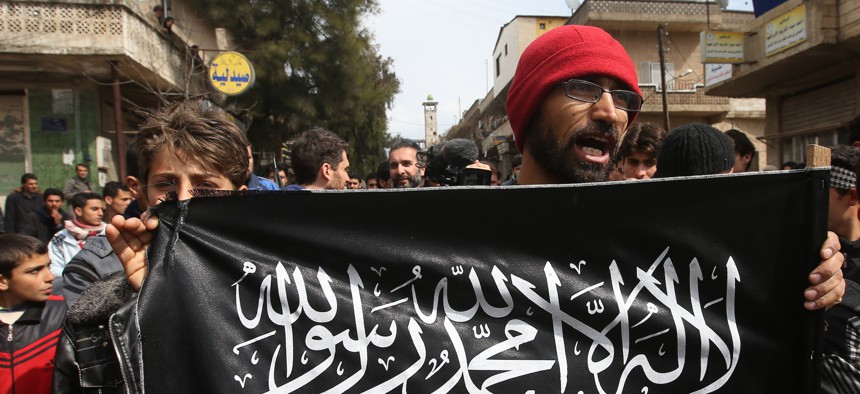
A 2013 photo of a man holding a Jabhat al-Nusra flag in Syria's Idlib province. The group has since rebranded itself Hayat Tahrir al-Sham, or HTS. AP / Hussein Malla
US Officials Just Mislabeled a Syrian Terror Group as al Qaeda. Worse, They’re Missing a Far Bigger Threat
The HTS group is not part of al Qaeda, but at loggerheads with it. Meanwhile, a smaller group is plotting global jihad.
On Thursday, the State Department amended its designation of Syria-based terrorist group Jabhat al-Nusra to include its new name: Hayat Tahrir al-Sham. This was necessary, if a little late — HTS has been operational for 16 months — and the United States is right to retain some attention on jihadist threats other than ISIS that emanate from Syrian territory.
But in amending the designation, State’s Coordinator for Counterterrorism, Ambassador Nathan A. Sales, declared that HTS is an affiliate of al Qaeda and the the U.S. would not be “fooled” by its attempts to hide that. Yet evidence has been piling up for several months that this label is inaccurate.
In fact, HTS and al Qaeda have fought, killed, arrested, and threatened each other repeatedly over the past year. Countless leading al Qaeda figures around the world have publicly slammed HTS for betraying al Qaeda in favor of “nationalist” objectives. Almost everything HTS does in Syria today is in direct contravention of al Qaeda orders from the highest levels.
» Subscribed to The D Brief? Get the latest top national security and global military news delivered to your inbox every morning. Sign up here.
Decrying State’s error may seem to be quibbling over nuance. Indeed, HTS deserves all the international scrutiny it gets. It certainly has not become more moderate, and a great deal would need to change for it to stand any chance of losing the “terrorist” label. But getting this right matters. Labelling HTS as al Qaeda constrains U.S. policy to responses that treat the group like a globalist, jihadist movement, which it is not.
Moreover, in choosing to focus on HTS – which has dedicated itself to wholly local objectives inside Syria – the U.S. government is missing a far greater terrorist threat. In fracturing itself from al Qaeda, HTS lost control of hundreds of committed jihadists who remain wholly loyal to Osama bin Laden’s vision of global jihad. For these terrorists, the U.S. remains enemy number one; and northwestern Syria has become an invaluable safe-haven from which al Qaeda can exert itself internationally.
Many of these al Qaeda loyalists have now coalesced within a new jihadist group known as Tanzim Huras al-Din, or the Religious Guardians’ Organization. Headed up by al Qaeda veterans, including at least three members of the group’s global leadership council, Huras al-Din is a deeply dangerous movement that poses a potent terrorist threat to U.S. assets in the Middle East and beyond. Several of its leaders are thought to have been involved with al Qaeda’s brief 2014 foray into foreign attack plotting from Syria, which the U.S. government labelled the Khorasan Group. Others have arrived more recently from Iran, Yemen, and Afghanistan, personally dispatched by al Qaeda’s overall leader, Ayman al-Zawahiri. Smaller than HTS, Huras al-Din operates deeper in the shadows, pursuing global terror objectives with little or no footprint.
Counterterrorism has long shaped U.S. policy toward the Middle East. The Trump administration has repeatedly insisted that a core component of its Syria strategy is the durable defeat of terrorist groups, naming ISIS and al Qaeda as America’s principal targets. However, the U.S. is doing literally nothing to deal with the very real terrorist threat posed by the likes of Huras al-Din. Much like al Qaeda before 9/11 or ISIS before its shocking expansion in 2014, this al Qaeda group is operating in northwestern Syria with virtual impunity, with America back in the bullseye.
For now, Russia and Turkey have locked U.S. aircraft out of northwestern Syria’s airspace, prohibiting even CIA drones from operating there. This is troubling, but not irreversible. As the United States and Turkey negotiate the fate of towns like Manbij and both countries’ roles in northern Syria, the U.S. should make air access to the northwest a priority demand. Neither Russia nor Turkey have acted to counter Huras al-Din and its al Qaeda ilk, but the longer the group remains untouched, the more dangerous it will become. Paired with Russia and Turkey’s ongoing de-escalation of the northwest region, the conditions are ripe for a renewed collection of intelligence and a campaign of targeted strikes on key al Qaeda operatives deemed to pose an international terrorist threat.
The Trump administration and international community must also acknowledge the potential value of propping up counterweights to the likes of al Qaeda. Having severed U.S. support to Syrian-vetted armed opposition factions six months ago, there is little the administration can do to leverage on-the-ground military alternatives.
» Subscribe to our podcast Defense One Radio! Find our latest episode here.
Strong civil society has repeatedly proven a solid obstacle to extremist organizations attempting to introduce foreign agendas to local communities — but the Trump administration recently decided to cut all funding to programs in northwestern Syria involved in countering violent extremism and building the capacity and resiliency of civil society, local governance, education and activities like media and civil policing. That might save the White House some pocket money, but it represents a gift to our terrorist adversaries that could easily come back to bite us.



